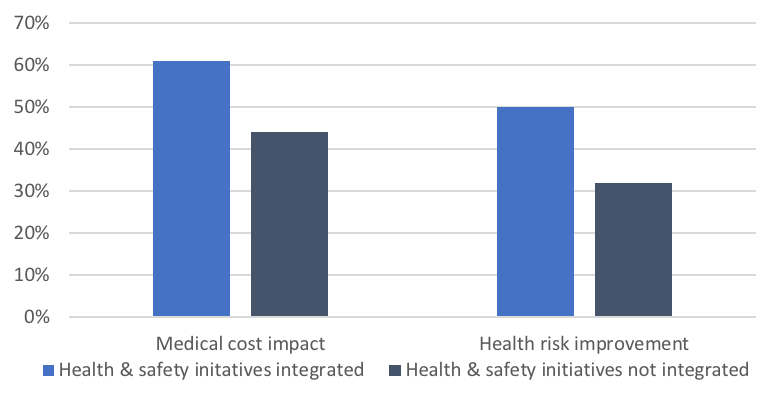 by Colleen Saringer, PhD
by Colleen Saringer, PhD
Colleen Saringer is a Lead Health and Well-Being Consultant at Alliant Employee Benefits. Colleen is responsible for partnering with client teams in the design, implementation, performance and evaluation of employer/employee health and well-being programs that are built around evidence-based best practices. Colleen’s research efforts focus on behavior change in the workplace through physical activity policy and environmental strategies.
Employees spend the majority of their waking hours at work, making the workplace an ideal setting to implement initiatives that can positively impact an employee’s health, well-being and safety. Not only does this benefit the employee, the company also benefits through reduced health care and worker’s compensation costs and greater employee productivity.1,2 However, in order to fully realize this employee/employer benefit, an organization must integrate efforts across departments responsible for worksite health and well-being (HWB), occupational health and safety, and employee benefits strategies.2
An effective, integrated approach is based on key characteristics that include leadership commitment; participation; policies, programs, and practices focused on positive working conditions; comprehensive and collaborative strategies; sustained organizational commitment; and data driven change.3 While it is often difficult to analyze all key characteristics at one time within an organization, the HERO Health and Well-Being Best Practices Scorecard in Collaboration with Mercer© (HERO Scorecard) provides the opportunity to analyze the integration of health, well-being and safety through the lens of leadership commitment, program participation and data driven change. An analysis was conducted on 1,027 companies to determine if organizations that align their HWB initiatives with safety and connect their initiatives to broader business objectives have better health and medical cost outcomes.
Program Integration
There are three ways in which HWB and safety integration is assessed within the HERO Scorecard: 1) through the integration of safety into HWB program goals and objectives; 2) HWB program elements (e.g. physical activity or stress management) are included within the safety program; and 3) HWB and safety program data are combined for data analytics. Although 55% of the responding organizations either did not integrate or did not have a safety program (39% and 16% respectively), 43% integrated HWB and safety in at least one of the three ways that integration is measured within the HERO Scorecard. Although the concept of an integrated HWB and safety model is not new, 41% of the responding organizations report that conversations are still being had centered on obtaining leadership buy-in to build an integrated initiative.
Leadership Commitment
Comprehensive and integrated initiatives must have buy-in from leaders across departments in order to be successful.3 Within the HERO Scorecard, 47% of senior leaders believed that “to some extent” the HWB program was connected to broader business results (e.g. increased revenue, profitability, overall success and sustainability), while 26% believed that this connection existed “to a great extent.” When comparing integration practices between these two leadership groups, 52% of organizations with leaders who believed a connection existed to a great extent integrated their practices, compared to 49% of those who believed a connection existed to some extent. As previously noted, work remains to close the gap among the siloed initiatives, and gaining leadership buy-in is critical. Without leadership support, the success and sustainability of an integrated approach is threatened because leaders are central to communicating the vision, motivating all levels of management to embrace the vision, enacting policies and practices and establishing organizational accountability.3
The Impact
Performance metrics are imperative when supporting the business case and gaining buy-in from organizational leaders. It has been shown that when HWB and safety initiatives are integrated, organizations experience an uptick in employee program participation,4,5 potentially impacting downstream outcomes such as health risks or medical trend. Although the HERO Scorecard does not require that an employer report participation in health risk assessments, biometric screenings or lifestyle coaching, the average employee participation rates among those that did were 50%, 47% and 26% respectively. These participation rates are consistent with average participation rates published elsewhere.6 However, we wanted to determine if leadership buy-in and integration had impact on employee participation in these programs. Therefore a comparison was performed between organizations whose leaders believed that the HWB program connects to the broader business results, and integrated HWB and safety initiatives, to those who believed there was a connection, but did not integrate. Among both groups, equal participation rates were seen in health risk assessment and biometric completions. However this was not the case with lifestyle coaching, where greater participation was experienced when leadership connected the results and integrated the two programs. This is a valuable finding as health risk assessments and biometric screenings focus more on education, whereas lifestyle coaching programs focus on behavior change, offering tremendous opportunity for participants to improve their health. For organizations whose leaders believe HWB is connected to broader business results and also integrate safety with HWB, greater than 50% of the responding organizations experienced health risk improvement, and greater than 61% experienced medical trend impact. These outcomes are substantially better than those in organizations whose leaders believe HWB is connected to business results but that do not integrate programs, where only 32% achieved health risk improvement and 44% realized medical cost impact.
Health risk improvement and medical cost impact

Conclusions
These findings suggest that organizations with both HWB and safety programs in place should consider integrating their HWB and safety initiatives to fully realize the potential benefits of these investments. However, leadership support is a key component to the success of the integration. With leadership support in place, health risk improvements and medical trend impact can be experienced over time. Therefore, prior to launch of the integration efforts, organizational leaders should commit to play an active role in order to assure program success, growth and sustainability.
This commentary is based on data from the HERO Scorecard Benchmark Database through December 31, 2018.
References:
- Bipartisan Policy Center and De Beaumont. Good Health is Good Business. June 2019. Available at: https://bipartisanpolicy.org/report/good-health-is-good-business/
- Sorensen G, Barbeau E. Steps to a Healthier U.S. Workforce: Integrating Occupational Health and Safety and Worksite Health Promotion: State of the Science. 2004.
- Harvard H.H. Chan School of Public Health Center for Work, Health and Well-being. Implementing an Integrated Approach: Weaving Worker Health, Safety, and Well-being into the Fabric of Your Organization. 2017.
- Sorensen G, et al. Worker Participation in an Integrated Health Promotion/Health Protection Program: Results from the WellWorks Project. Health Education Quarterly. 1996; 23(2):191-203.
- Hunt, MK, et al. Process evaluation of an integrated health promotion/occupational health model in wellworks-2. Health Education and Behavior. 2005; 32(1):10-26.
- Mattke S, Liu HH, Caloyeras JP, Huang CY, Van Busum KR, Khodyakov D, and Shier V. Workplace Wellness Programs Study: Final Report. Santa Monica, CA: RAND Corporation, 2013. https://www.rand.org/pubs/research_reports/RR254.html.
